NVIDIA's GeForce GTX 580: Fermi Refined
by Ryan Smith on November 9, 2010 9:00 AM ESTCompute and Tessellation
Moving on from our look at gaming performance, we have our customary look at compute performance, bundled with a look at theoretical tessellation performance. Unlike our gaming benchmarks where NVIDIA’s architectural enhancements could have an impact, everything here should be dictated by the core clock and SMs, with shader and polymorph engine counts defining most of these tests.
Our first compute benchmark comes from Civilization V, which uses DirectCompute to decompress textures on the fly. Civ V includes a sub-benchmark that exclusively tests the speed of their texture decompression algorithm by repeatedly decompressing the textures required for one of the game’s leader scenes.
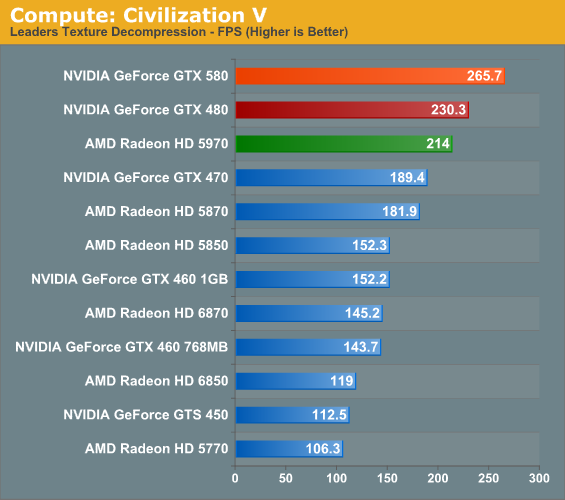
We previously discovered that NVIDIA did rather well in this test, so it shouldn’t come as a surprise that the GTX 580 does even better. Even without the benefits of architectural improvements, the GTX 580 still ends up pulling ahead of the GTX 480 by 15%. The GTX 580 also does well against the 5970 here, which does see a boost from CrossFire but ultimately falls short, showcasing why multi-GPU cards can be inconsistent at times.
Our second compute benchmark is Cyberlink’s MediaEspresso 6, the latest version of their GPU-accelerated video encoding suite. MediaEspresso 6 doesn’t currently utilize a common API, and instead has codepaths for both AMD’s APP (née Stream) and NVIDIA’s CUDA APIs, which gives us a chance to test each API with a common program bridging them. As we’ll see this doesn’t necessarily mean that MediaEspresso behaves similarly on both AMD and NVIDIA GPUs, but for MediaEspresso users it is what it is.
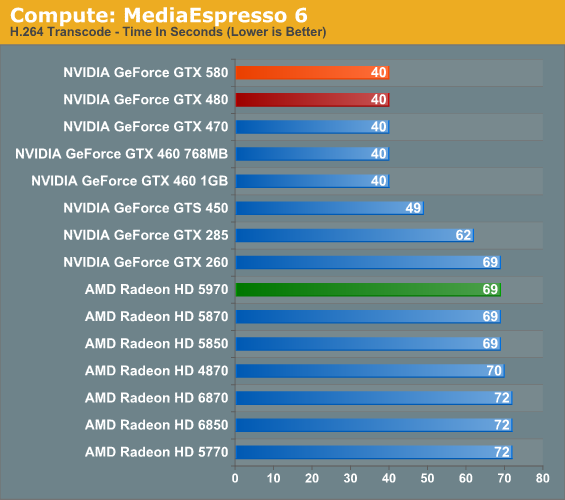
We throw MediaEspresso 6 in largely to showcase that not everything that’s GPU accelerated is GPU-bound, as ME6 showcases this nicely. Once we move away from sub-$150 GPUs, APIs and architecture become much more important than raw speed. The 580 is unable to differentiate itself from the 480 as a result.
Our third GPU compute benchmark is SmallLuxGPU, the GPU ray tracing branch of the open source LuxRender renderer. While it’s still in beta, SmallLuxGPU recently hit a milestone by implementing a complete ray tracing engine in OpenCL, allowing them to fully offload the process to the GPU. It’s this ray tracing engine we’re testing.
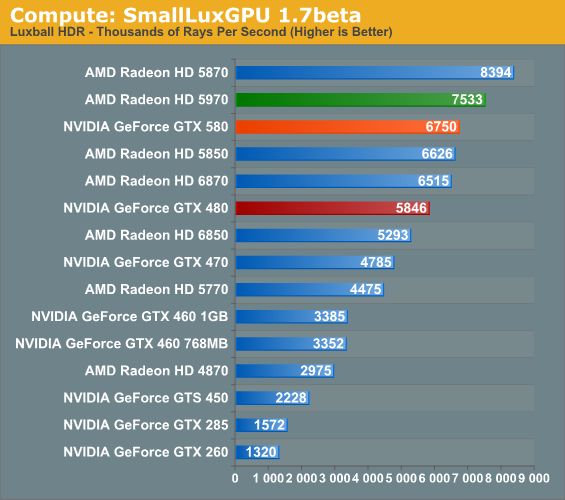
SmallLuxGPU is rather straightforward in its requirements: compute and lots of it. The GTX 580 attains most of its theoretical performance improvement here, coming in at a bit over 15% over the GTX 480. It does get bested by a couple of AMD’s GPUs however, a showcase of where AMD’s theoretical performance advantage in compute isn’t so theoretical.
Our final compute benchmark is a Folding @ Home benchmark. Given NVIDIA’s focus on compute for Fermi and in particular GF110 and GF100, cards such as the GTX 580 can be particularly interesting for distributed computing enthusiasts, who are usually looking for the fastest card in the coolest package. This benchmark is from the original GTX 480 launch, so this is likely the last time we’ll use it.
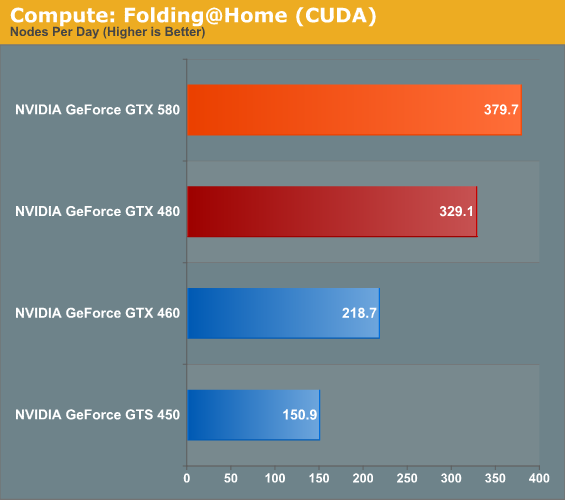
If I said the GTX 580 was 15% faster, would anyone be shocked? So long as we’re not CPU bound it seems, the GTX 580 is 15% faster through all of our compute benchmarks. This coupled with the GTX 580’s cooler/quieter design should make the card a very big deal for distributed computing enthusiasts.
At the other end of the spectrum from GPU computing performance is GPU tessellation performance, used exclusively for graphical purposes. Here we’re interesting in things from a theoretical architectural perspective, using the Unigine Heaven benchmark and Microsoft’s DirectX 11 Detail Tessellation sample program to measure the tessellation performance of a few of our cards.
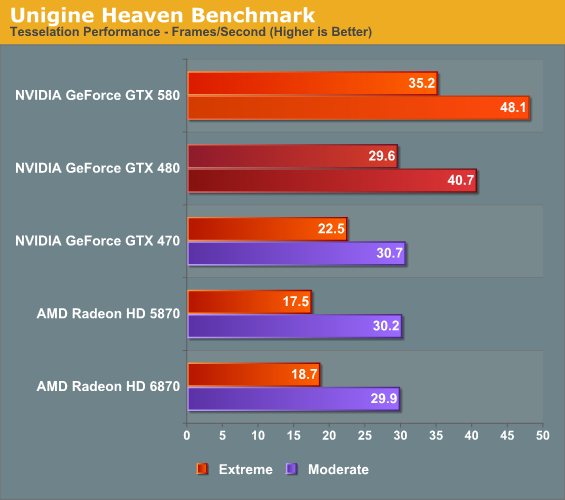
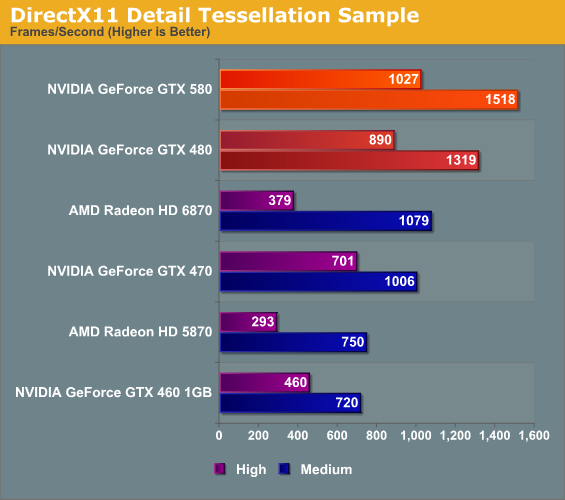
NVIDIA likes to heavily promote their tessellation performance advantage over AMD’s Cypress and Barts architectures, as it’s by far the single biggest difference between them and AMD. Not surprisingly the GTX 400/500 series does well here, and between those cards the GTX 580 enjoys a 15% advantage in the DX11 tessellation sample, while Heaven is a bit higher at 18% since Heaven is a full engine that can take advantage of the architectural improvements in GF110.
Seeing as how NVIDIA and AMD are still fighting about the importance of tessellation in both the company of developers and the public, these numbers shouldn’t be used as long range guidance. NVIDIA clearly has an advantage – getting developers to use additional tessellation in a meaningful manner is another matter entirely.










160 Comments
View All Comments
RussianSensation - Wednesday, November 10, 2010 - link
Very good point techcurious. Which is why the comment in the review about having GTX580 not being a quiet card at load is somewhat misleading. I have lowered my GTX470 from 40% idle fan speed to 32% fan speed and my idle temperatures only went up from 38*C to 41*C. At 32% fan speed I can not hear the car at all over other case fans and Scythe S-Flex F cpu fan. You could do the same with almost any videocard.Also, as far as FurMark goes, the test does test all GPUs beyond their TDPs. TDP is typically not the most power the chip could ever draw, such as by a power virus like FurMark, but rather the maximum power that it would draw when running real applications. Since HD58/68xx series already have software and hardware PowerPlay enabled which throttles their cards under power viruses like FurMark it was already meaningless to use FurMark for "maximum" power consumption figures. Besides the point, FurMark is just a theoretical application. AMD and NV implement throttling to prevent VRM/MOSFET failures. This protects their customers.
While FurMark can be great for stability/overclock testing, the power consumption tests from it are completely meaningless since it is not something you can achieve in any videogame (can a videogame utilize all GPU resources to 100%? Of course not since there are alwasy bottlenecks in GPU architectures).
techcurious - Wednesday, November 10, 2010 - link
How cool would it be if nVidia added to it's control panel a tab for dynamic fan speed control based on 3 user selectable settings.1) Quiet... which would spin the fan at the lowest speed while staying just enough below the GPU temperature treshold at load and somewhere in the area of low 50 C temp in idle.
2) Balanced.. which would be a balance between moderate fan speed (and noise levels) resulting in slightly lower load temperatures and perhaps 45 C temp in idle.
3) Cool.. which would spin the fan the fastest, be the loudest setting but also the coolest. Keeping load temperatures well below the maximum treshold and idle temps below 40 C. This setting would please those who want to extend the life of their graphics card as much as possible and do not care about noise levels, and may anyway have other fans in their PC that is louder anyway!
Maybe Ryan or someone else from Anandtech (who would obviously have much more pull and credibility than me) could suggest such a feature to nVidia and AMD too :o)
BlazeEVGA - Wednesday, November 10, 2010 - link
Here's what I dig about you guys at AnandTech, not only are your reviews very nicely presented but you keep it relevant for us GTX 285 owners and other more legacy bound interested parties - most other sites fail to provide this level of complete comparison. Much appreciated. You charts are fanatastic, your analysis and commentary is nicely balanced and attention to detail is most excellent - this all makes for a more simplified evaluation by the potential end user of this card.Keep up the great work...don't know what we'd do without you...
Robaczek - Thursday, November 11, 2010 - link
I really liked the article but would like to see some comparison with nVidia GTX295..massey - Wednesday, November 24, 2010 - link
Do what I did. Lookup their article on the 295, and compare the benchmarks there to the ones here.Here's the link:
http://www.anandtech.com/show/2708
Seems like Crysis runs 20% faster at max res and AA. Is a 20% speed up worth $500? Maybe. Depends on how anal you are about performance.
lakedude - Friday, November 12, 2010 - link
Someone needs to edit this review! The acronym "AMD" is used several places when it is clear "ATI" was intended.For example:
"At the same time, at least the GTX 580 is faster than the GTX 480 versus AMD’s 6800/5800 series"
lakedude - Friday, November 12, 2010 - link
Never mind, looks like I'm behind the times...Nate007 - Saturday, November 13, 2010 - link
In the end we ( the gamers) who purchase these cards NEED to be be supporting BOTH sides so the AMD and Nvidia can both manage to stay profitable.Its not a question of who Pawns who but more importantly that we have CHOICE !!
Maybe some of the people here ( or MOST) are not old enough to remember the days when mighty
" INTEL" ruled the landscape. I can tell you for 100% fact that CPU's were expensive and there was no choice in the matter.
We can agree to disagree but in the END, we need AMD and we need NVIDIA to keep pushing the limits and offering buyers a CHOICE.
God help us if we ever lose one or the other, then we won't be here reading reviews and or jousting back and forth on who has the biggest stick. We will all be crying and complaining how expense it will be to buy a decent Video card.
Here's to both Company's ..............Long live NVIDIA & AMD !
Philip46 - Wednesday, November 17, 2010 - link
Finally, at the high end Nvidia delivers a much cooler and quiter, one GPU card, that is much more like the GTX 460, and less like the 480, in terms of performance/heat balance.I'm one where i need Physx in my games, and until now, i had to go with a SLI 460 setup for one pc and for a lower rig, a 2GB 460 GTX(for maxing GTA:IV out).
Also, i just prefer the crisp Nvidia desktop quality, and it's drivers are more stable. (and ATI's CCC is a nightmare)
For those who want everything, and who use Physx, the 580 and it's upcoming 570/560 will be the only way to go.
For those who live by framerate only, then you may want to see what the next ATI lineup will deliver for it's single GPU setup.
But whatever you choose, this is a GREAT thing for the industry..and the gamer, as Nvidia delivered this time with not just performance, but also lower temps/noise levels, as well.
This is what the 480, should have been, but thankfully they fixed it.
swing848 - Wednesday, November 24, 2010 - link
Again, Anand is all over the place with different video cards, making judgements difficult.He even threw in a GTS 450 and an HD 4870 here and there. Sometimes he would include the HD 5970 and often not.
Come on Anand, be consistent with the charts.